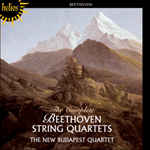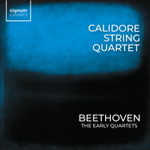
Welcome to Hyperion Records, a British classical label devoted to presenting high-quality recordings of music of all styles and from all periods from the twelfth century to the twenty-first.
Hyperion offers both CDs, and downloads in a number of formats. The site is also available in several languages.
Please use the dropdown buttons to set your preferred options, or use the checkbox to accept the defaults.

| Calidore String Quartet» More |
The first movement is one of the most succinct and muscular statements in early Beethoven, and the first figure generates a remarkable range of growth. The directness and simplicity of its beginning did not come all at once; the sketches show that it had to be hammered out, and the way its terseness serves to make room for later expansion foreshadows the extraordinary achievement of Op 95. Notice how the little turning figure in the first theme is soon overlaid by a new counterpoint and then, as the music moves to the dominant, the second group floats and expands (with gentle syncopations) in a way we might not have supposed possible in a piece with so crisp a start. In the revision the development was drastically altered in its range of modulation and the perfection of its part-writing — of all the Opus 18 Quartets, this shows most democracy between the instruments.
Beethoven told Amenda that when composing the slow movement he had Romeo and Juliet in mind. He more than once responded to the promptings of Shakespeare but, as with the 'Pastoral' Symphony, would have insisted that the result was 'more an expression of feeling than painting'. This passionate D minor movement has something in common with the 'Largo e mesto' of the piano sonata in D, op 10 no 3. Both spaciously express a sense of tragedy beyond the ken of any of Beethoven's predecessors except Gluck, and the Quartet movement has a new refinement of sound, partly due to the way in which the composer removed many of the more vehement markings of the first version. The fining down of the dynamics makes all the more striking the intense outburst towards the end.
After this the Scherzo, far from being the usual release of energy after the restraints of a slow movement, is almost soothing. This is another sign of maturity — a quality we must never underestimate in Beethoven's early masterpieces. Too often his Opus 18 Quartets are patronisingly treated as the promising products of a student of genius, and we must not forget that already Beethoven is active in a territory unpredictable even by Haydn and Mozart. When these works were first heard the impression was of disconcerting but dazzling mastery of novel ideas. By the time this F major Quartet appeared, audiences were prepared for a fiercely aggressive Beethoven scherzo, so the quiet nature of this one provided a new kind of surprise, not contradicted by the abrupt humour of the humorously modulating Trio with its skipping octaves. In this Scherzo there is, as Basil Lam says, an element of 'unrest that links it with the first half of the Quartet' — but it is also an easement towards the rondo Finale.
When he revised it, Beethoven changed the marking for the Finale from 'Allegretto' to 'Allegro'. This means that he first thought of a not excessive speed, but may have felt that 'Allegretto' suggested too slow a pace. The 'Allegro' marking does not really mean 'very fast' (we have to remember that the literal meaning of the word is cheerful' or 'lively' — not quick) and there is great risk to the detail if the piece is rushed; its rhythmic vitality is the stronger for not being hurried. The quicksilver first subject is contrasted with singing elements that give the piece great spaciousness, and in this respect it balances the first movement. The development shows Beethoven's already great mastery of polyphony, a skill for which he has not always been given the credit. To the academics smoothness used to be the only acceptable attribute of good counterpoint.
from notes by Robert Simpson © 1990
Dans le premier mouvement — l'un des plus succincts et des plus forts du jeune Beethoven — le premier motif donne naissance à une remarquable suite de développements. La clarté et la simplicité de son début ne furent pas trouvées d'emblée; les carnets d'esquisses montrent qu'il a été longuement retravaillé et l'adresse avec laquelle sa concision ouvre la voie au développement ultérieur préfigure l'extraordinaire degré d'achèvement de l'Opus 95. Remarquez comment le petit motif du premier thème est bientôt couvert par un nouveau contrepoint et, tandis que la musique chemine vers la dominante, comment le second groupe flotte puis se développe (en nobles syncopes) d'une façon tout à fait inattendue après un début aussi concis. Lors de sa révision, le développement a été radicalement modifié dans son cheminement harmonique et dans l'écriture de ses parties — de tous les quatuors de l'Opus 18, c'est dans celui-ci que les instruments sont traités avec le plus d'égalité.
Beethoven confia à Amenda qu'en composant le mouvement lent, il avait Roméo et Juliette à l'esprit. Il fut plus d'une fois sensible à Shakespeare mais, comme pour la symphonie 'pastorale', il expliquait qu'il s'en inspirait 'bien plus pour exprimer un sentiment que pour le décrire'. Ce mouvement passionné a quelque chose de commun avec le 'Largo e mesto' de la sonate pour piano en ré majeur, op 10, no 3. Chacune de ces oeuvres exprime puissamment un sens de la tragédie qu'aucun des prédécesseurs de Beethoven ne sut maîtriser à ce point, sauf Gluck, et la sonorité du quatuor est d'un raffinement nouveau dû en partie aux modifications que le compositeur apporta aux éléments les plus impétueux de la première version. Le contraste dynamique rend l'intense déchainement de la fin encore plus expressif.
Après cela, loin de libérer une énergie quelque peu réprimée dans un mouvement lent, le Scherzo est presque calme. C'est un autre signe de maturité — une qualité que nous ne devons jamais mésestimer dans les premières oeuvres de Beethoven. Son opus 18 est trop souvent considéré avec condescendance comme l'oeuvre prometteuse d'un futur génie mais il ne nous faut perdre de vue que, déjà, Beethoven compose dans un genre imprévisible même par Haydn et Mozart. Dès leur premiere audition, ces oeuvres firent forte impression par leur maîtrise déconcertante mais éblouissante d'idées novatrices. Lors de la création du quatuor en fa majeur, le public s'attendait à un scherzo beethovénien violent et agressif et le calme de ce movement provoqua une nouvelle manière de surprise que ne contraria pas l'humour abrupt des joyeuses modulations et des sauts d'octaves du Trio. Comme le dit Basil Lam, il y a dans ce Scherzo 'une sorte d'agitation qui le relie à la première moitié du quatuor' — mais il conduit également au rondo Finale.
Lorsqu'il le révisa, Beethoven remplaça l'indication 'Allegretto' du Finale par celle de 'Allegro'. Il avait donc pensé d'emblée à un tempo moyen mais craignit ensuite que la mention 'Allegretto' ne suggère une allure trop lente. L'indication 'Allegro' ne signifie pas pour autant 'très vite' (souvenons-nous qu'au sens littéral, ce mot signifie 'allègre' ou 'gai' — et non 'rapide') et les détails souffriraient d'une allure trop vive. La vitalité rhythmique du morceau perdrait de sa force. Le contraste entre la vivacité du premier motif et les éléments mélodiques donne à la pièce une grande profondeur et, à cet égard, le Finale équilibre le premier mouvement. Le développement montre la grande maîtrise que Beethoven a déjà de l'écriture polyphonique, talent qui ne lui a pas toujours été reconnu. Pour les représentants de l'académisme, un bon contrepoint se reconnaît essentiellement à son homogénéité.
extrait des notes rédigées par Robert Simpson © 1990
Français: Jacqueline Letteron
Der erste Satz ist einer der prägnantesten und zugleich gehaltvollsten der frühen Beethoven-Werke und die erste Phrase zeichnet sich durch eine bemerkenswerte Steigerung aus. Vorerst was der Anfang nicht so einfach und direkt ausgestaltet. Wie Skizzen belegen, musste die Endfassung erst langwierig herausgearbeitet werden. Die Art wie die anfängliche Schlichtheit in der Folge in grössere Breite mündet, gibt einen Vorgeschmack auf die Grossartigkeit des Op 95. Bemerkenswert ist, wie die kleine, wiederkehrende Phrase des ersten Themas bald von einem neuen Kontrapunkt überlagert wird, um dann, im Hauptteil eine zweite Taktgruppe (mit sanften Synkopen) erweiternd einfliessen zu lassen; und dies in einer Art und Weise, wie man es nach einem derart sachlichen Beginn kaum erwartet hätte. In den Überarbeitungen wurde der Aufbau des Werkes drastisch verändert, sowohl in Tonlage als auch in seiner vollendeten Gliederung. Von all den Quartetten des Opus 18 zeigt dieses die grösste Ausgeglichenheit zwischen den Instrumenten.
Beethoven erzählte Amenda, dass er beim Komponieren dieses langsamen Satzes an Romeo und Julia gedacht habe. Mehr als nur einmal worde er durch Shakespeare inspiriert aber beabsichtigte, wie schon bei der Symphonie 'Die Pastorale', seine Gefünle eher auszudrücken als diese zu malen. Der leidenschaftliche Satz in D-Moll hat etwas gemeinsam mit dem 'Largo e mesto' der Sonate für Klavier in D-Dur, Op 10 Nr. 3. Beide drücken umfassend etwas Tragödienhaftes aus, jenseits der Reichweite jedes anderen Beethovenvorgängers, mit Ausnahme von Gluck. Den Quartett-Satz zeichnet ein neues Klangvertändnis aus, das teilweise zurückzuführen ist auf das Entfernen von kräftigen Akzenten der ersten Version. Dieses Zurücknehmen der Dynamik lässt zudem den kraftvollen Ausbruch gegen Ende deutlicher hervortreten.
Nach alledem und einem eher nüchternen langsamen Satz, wirkt das Scherzo das die gewohnte Energieentladung völlig vermissen lässt, fast ausgleichend. Dies ist ein weiterer Ausdruck von Reife — eine Dimension über die wir keinesfalls in Beethovens Frühwerk hinwegsehen dürfen. Seine Quartette aus Opus 18 werden auch oft herablassend als die vielversprechenden Produkte eines genialen Studenten bezeichnet. Doch wir sollten nicht vergessen, dass Beethoven in dieser Zeit schon in Gebieten aktiv war, die unvorstellbar sogar bei Haydn und Mozart waren. Als man diese Werke zum ersten Mal hörte, war man zwar verwirrt, es wurden jedoch die neuer Ideen erfreut aufgenommen. Als dann dieses Quartett in F-Dur erschien, war das Publikum auf ein hitziges Scnerzo eingestellt, sodass der ruhige Charakter dieses Stückes aufs neue überraschte. Es stand zudem nicht im Gegensatz mit dem Witz des humorvoll gestalteten Trios und seinen Oktaven-Sprüngen. In diesem Scherzo findet sich, wie Basil Lam schreibt, eine Art 'Unrast, die es mit der ersten Hälfte des Quartetts verbindet' - aber es stellt auch eine Auflockerung dar, die zum Rondo Finale hinführt.
Beethoven änderte in der Überarbeitung die Bezeichnung des Finales von 'Allegretto' zu 'Allegro'. Nach seinem Willen sollte das Finale nicht zu schnell sein, jedoch gewann er anscheinend den Eindruck, dass die Bezeichnung 'Allegretto' zu langsam sei. 'Allegro' steht nicht für 'sehr schnell', die wörtliche Übersetzung ist 'neiter' oder 'lebendig', was eine zu stürmiche Interpretation von Teilen des Stückes bedeuten würde. Seine rhythmische Vitalität ist um so stärker, wenn Hast vermieden wird. Dieser lebhafte erste Abschnitt durch Gesangselemente herausgestrichen, schafft einen Ausgleich zum ersten Satz und verleiht dem Stück Raum. Die schrittweise Entfaltung des Stückes zeigt Beethovens weitreichendes Verständnis für die Polyphonie, eine Fähigkeit, die ihm nicht wirklich zuerkannt wurde. Für gewisse Kenner zeichnet vorallem Einfachheit einen guten Kontrapunkt aus.
aus dem Begleittext von Robert Simpson © 1990
Deutsch: Stefan Kapelar
 Beethoven: String Quartets Beethoven: String Quartets‘Fine performances, always intelligent, with many considerable insights … perfect intonation and excellent ensemble and tonal blend, with first-c ... ‘Very fine … I enjoyed these performances because they deliver Beethoven as I want him, free of the biographical sensationalism. Highly recommend ...» More |
 Beethoven: The early quartets Beethoven: The early quartetsThe string quartet was perhaps the most prestigious (and certainly the most lucrative) genre for a composer at the turn of the nineteenth century. Beethoven left nothing to chance with his inaugural Op 18 set, and they were a triumph, here perform ...» More |

